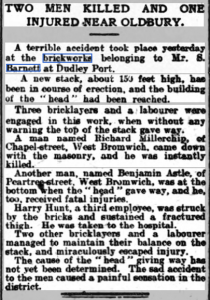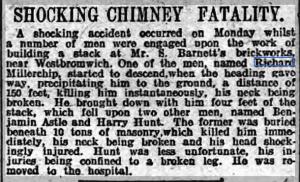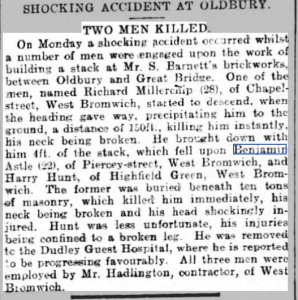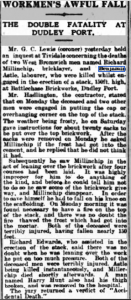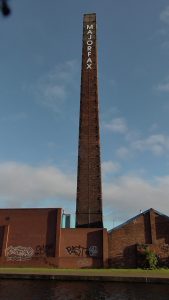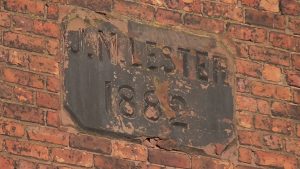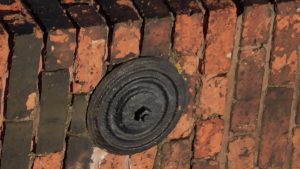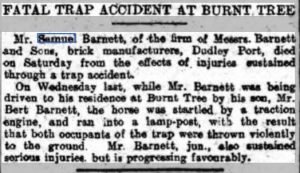There are so many layers comprised within the Rattlechain site and its history, and just when I thought I had got to the bottom of one aspect, up surprisingly pops another piece of the jigsaw which reveals a new set of research.
Samuel Barnett’s part in this sorry tale- digging the marl hole that would become the lagoon was obviously not without its dangers. We of course know quite a bit about the 1899 canal breach, but little of what happened after this at the site in the following years. The excellent British Newspaper archive has again turned up something surprising which I have not read about before, which is very odd as it involved the deaths of some of his workforce at the site. Unlike the breach, these deaths claimed the lives of two men who were erecting a new brick chimney at the works.
The following article was published in The Birmingham Daily Gazette on 23rd January 1906.
We learn here that this new structure was around 150 feet high when three workers were involved during its collapse.
Richard Millerchip of Chapel Street , and Benjamin Astle of Peartree Street, both West Bromwich paid with their lives and died in their trade by building for Barnett. Another man Harry Hunt was also seriously injured by the falling bricks.
Another article from the Wellington Journal on 27th January 1906 states that Millerchip was descending the stack when it gave way,
A further article from the Gloucestershire Echo reveals the ages of the two men, Millerchip 28 and Astle 22. There is gruesome detail about both men’s necks being broken and Astle being buried beneath ten tonnes of masonry.
Named in this article is the contractor working for Barnett- a Mr Hadlington also of West Bromwich.
I have also now found the coroners verdict on this “accident”, with Samuel Barnett and his endeavours appearing to conjure a myriad of them, including his own when he lost an arm. Perhaps unsurprisingly, Hadlington blamed the dead. This 25th January article from the Birmingham Daily gazette blames Richard Millerchip for leaning over the edge and also frost thawing out the mortar when a fire was lit. It is unclear from this article and the first if Astle fell or was fallen upon.
No doubt this setback at the works was soon remedied by someone else stepping into the dead men’s shoes. We have an idea of a scale of this finished article from a picture of the stack in 1950, overlooking the now watery lagoon that Albright and Wilson would have been dumping in.

